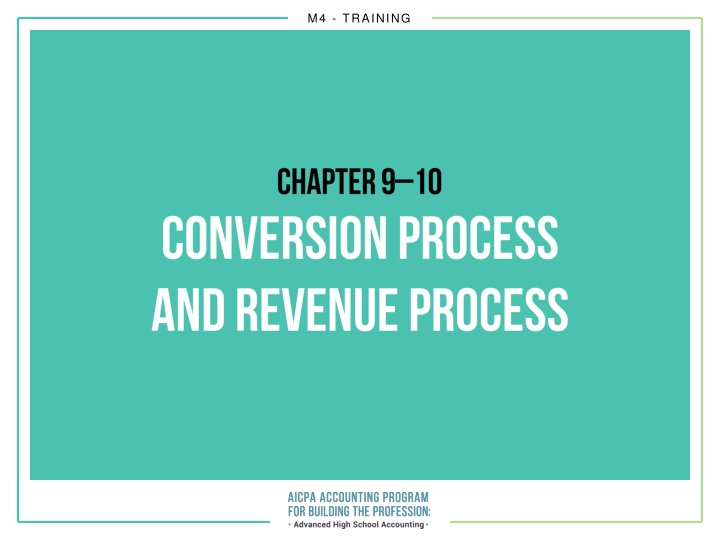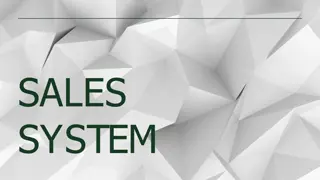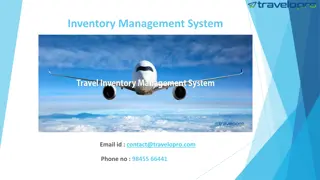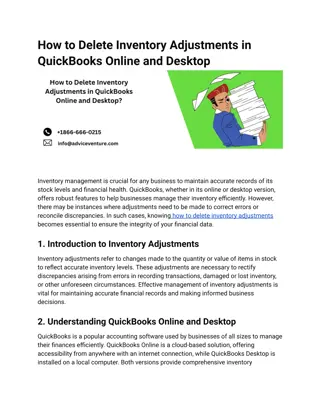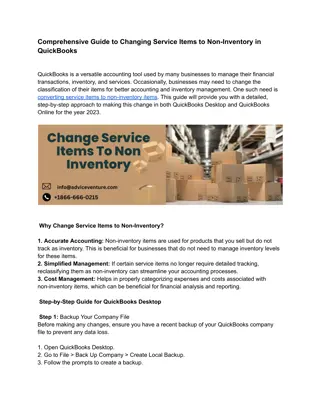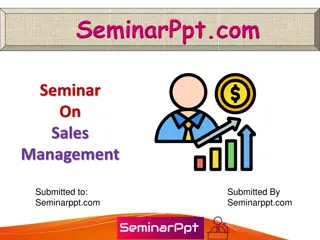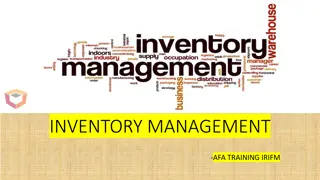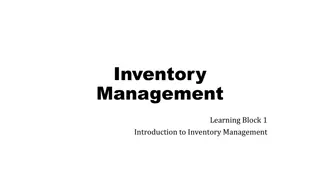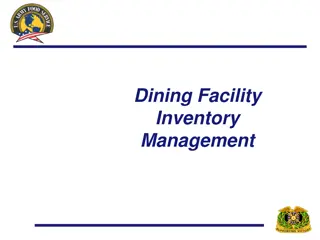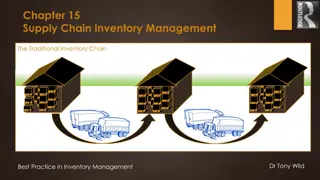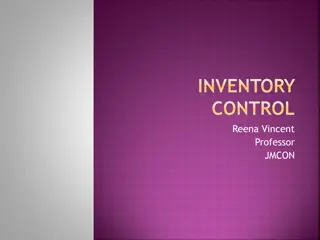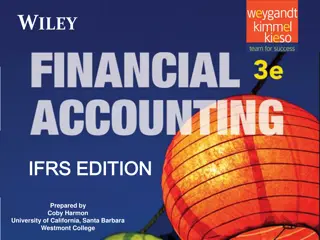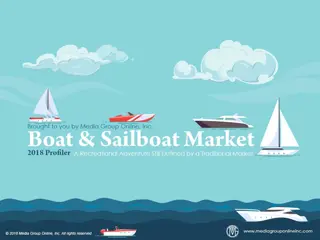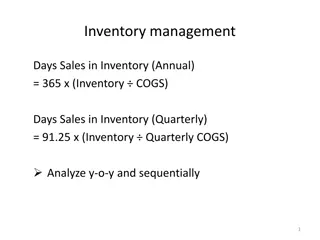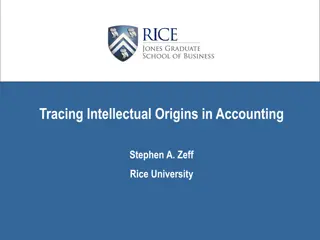Accounting for Sales and Inventory Module
This module covers topics such as revenue recognition, inventory costing methods, manufacturing process activities, direct materials and labor costs, cost of goods sold, and financial statements in the context of generally accepted accounting principles.
Download Presentation

Please find below an Image/Link to download the presentation.
The content on the website is provided AS IS for your information and personal use only. It may not be sold, licensed, or shared on other websites without obtaining consent from the author.If you encounter any issues during the download, it is possible that the publisher has removed the file from their server.
You are allowed to download the files provided on this website for personal or commercial use, subject to the condition that they are used lawfully. All files are the property of their respective owners.
The content on the website is provided AS IS for your information and personal use only. It may not be sold, licensed, or shared on other websites without obtaining consent from the author.
E N D
Presentation Transcript
M4 - TRAINING Click to edit Master subtitle style
M4 - TRAINING Chapter 9 Overview Conversion process Manufacturing costs Direct Materials Direct Labor Manufacturing Overhead Cost drivers used to estimate overhead for Facility-sustaining Product-sustaining Batch-related Unit-related
M4 - TRAINING Chapter 10 Overview Revenue Process Activities Accrual basis Uncollectible accounts Cost of goods sold Fifo Lifo Revenue Process and Financial Statements
M4 - TRAINING MODULE 4: ACCOUNTING FOR SALES AND INVENTORY Chapter 9 & 10 Learning Objectives: 1. Apply generally accepted accounting principles to the sales and collection process. 2. Apply generally accepted accounting principles to the inventory and cost of goods sold. Student Outcomes Topic* Ch & Time 4.1 Describe the criteria used to determine revenue recognition. F 4.2 Record revenue-related transactions. F Explain the accounting methods used to determine the value of accounts receivable to be reported on the balance sheet and describe the effect on the income statement. 4.3 F Ch 10 (p 276 294) 6 hours 4.4 Record transactions for accounts receivable, including uncollectible accounts, write-offs, and recoveries. F Identify and describe the cost flow assumptions for inventory and explain the impact on the balance sheet and income statement. 4.5 F 4.6 Calculate cost of goods sold and ending inventory using LIFO and FIFO inventory costing methods. F 4.7 Explain how inventory for a manufacturing business differs from inventory for a merchandising business. M Explain how an activity-based costing system operates, including the identification of activity cost pools, and the selection of cost drivers. 4.8 M 4.9 Explain the flow of costs through the manufacturing accounts used in product costing. M Ch 9 (p 247 258) 4 hours 4.10 Compute a predetermined overhead rate, and explain its use in job-order costing. M 4.11 Determine whether manufacturing overhead is over/under-applied. Prepare journal entries to record the costs of direct material, direct labor, and manufacturing overhead in a job- order costing system. M 4.12 M Prepare a schedule of cost of goods manufactured, a schedule of cost of goods sold, and an income statement for a manufacturer. 4.12 M Module 4 Total Hours 10 Hours
M4 - TRAINING Chapter 9 Conversion Process Conversion process is only involved in manufacturing businesses. What are the conversion process activities? Schedule production. Obtain direct materials. Use labor and resources to convert materials into finished goods. Store finished goods until sold.
M4 - TRAINING What are the costs in the manufacturing process? Direct Materials The traceable costs incurred to purchase and receive direct materials. IPods Plastic cases, components, processors Publishing company Paper, ink, book covers, etc. Automobile manufacturer Tires, automobile metal parts, etc. Computer manufacturer Hard drives, monitors, etc. Keebler chocolate chip cookies Chocolate chips, flour, sugar Direct Labor Labor costs of employees who actually manufacture the product. The Keebler Elves wages would be included in this classification.
M4 - TRAINING Manufacturing Overhead All product costs other than direct material and direct labor, including indirect materials (see below), indirect labor (employees whose services support manufacturing such as factory janitors and supervisors), factory utilities, factory rent, factory depreciation *Indirect materials examples: IPods Glue Publishing company Glue, printing press lubricants, etc. Automobile manufacturer Factory light bulbs, drill bits etc. Assembly line lubricants, screwdrivers, polishers, etc. Cooking spray Computer manufacturer Keebler cookies *These indirect materials would be credited out of the asset Supplies when placed in production.
M4 - TRAINING Sample Problem Backpackers, Inc. plans to manufacture packs for hiking and camping. The following costs will be incurred in the manufacturing process. Classify each cost as one of the following four options by placing the number of the correct answer in the space provided. Direct materials cost Direct labor cost Manufacturing overhead cost Selling and administrative cost __________A. Cost of fabric __________B. Cost of the factory building __________C. Cost of advertising in various outdoor magazines __________D. Cost of thread used to sew packs together __________E. Cost of shelving to store production supplies __________F. Salary of the vice president of sales __________G. Cost of zippers __________H. Wages of sales personnel (salary plus commission) __________ I. Cost of delivery vehicle __________J. Cost of utilities used in the factory building __________K. Cost of utilities used in the corporate office __________L. Production supervisor s salary __________M. Setup costs to change production from one style pack to another __________N. Depreciation on delivery vehicle __________O. Wages of employees working on the assembly line DL DM MOH S&A MOH MOH S&A DM S&A S&A MOH S&A MOH MOH S&A
M4 - TRAINING Controlling accounts for inventory stages: Direct Materials Work in Process Finished Goods What is the purpose of the inventory accounts in a manufacturing company and what types of activities cause the accounts to increase and decrease? Direct (Raw) Materials Inventory the cost of direct materials on hand; increases when direct materials are purchased; decreases when direct materials are issued into production *In this chapter, indirect materials, which cannot be traced, or the cost is small enough that tracing is not warranted will be debited to Supplies . Work-in-ProcessInventory the cost of products started, but not completed; increases when direct materials and direct labor are used in production and when manufacturing overhead is assigned to production; decreases when goods are finished and transferred out (cost of goods manufactured) Finished Goods Inventory the cost of products finished, but not sold; increases when goods are finished and transferred in; decreases when goods are sold (cost of goods sold) How would you describe the flow of costs through the inventory accounts? See Exhibit 9.2
M4 - TRAINING Flow of Manufacturing Costs: Finished Goods Direct Materials Work In Process Costs of Goods Sold Cost of Goods Manufactured Cost of Goods Sold Purchase Direct Mat. Mat. Req. Jobs Completed Sold Direct Mat. Direct Labor Applied MOH Warehouse Inventory Over applied MOH will reduce COGS at period end closing Under applied MOH will add to COGS at period end closing Manufacturing Costs Manufacturing Overhead Applied: Actual: Recorded as an estimate to completed jobs Happen / recorded sporadically, not when jobs are completed Debit Balance=Under applied CreditBalance=Over applied
M4 - TRAINING Rogers Company had inventories at the beginning and end of 2006 as follows: _________________________________________________________ January 1, 2006 Raw materials inventory $49,000 Work-in-process inventory 106,400 Finished goods inventory 42,000 _________________________________________________________ During 2006, Rogers Company purchased direct materials of $560,000, incurred direct labor costs of $280,000, and applied manufacturing overhead of $462,000 to production. Show the flow of costs through the company s inventory account during 2006. December 31, 2006 $63,000 84,000 91,000 Direct Materials Inventory Work In Process Inventory Finished Goods Inventory 49,000 106,400 42,000 ? 546,000 ? ? COGS 1,261,400 560,000 DL 280,000 MOH 462,000 1,310,400 DM 546,000 COGM 1,310,400 63,000 84,000 91,000
M4 - TRAINING Assume ABC Company has a cost pool that varies with the number of machine hours used in production and another that varies with the number of production runs during the period. They must estimate the machine-related costs and the number of machine hours they will use in the coming period. And, they must estimate the production run costs and how many production runs will be required for the coming period. Let s assume that machine-related costs are estimated to be $500,000 and machine hours are estimated at 50,000 and that production run costs are estimated to be $400,000 and that 400 production runs will be required. What are the predetermined overhead rates? Answer: The cost per machine hour is $10 ($500,000/50,000) The cost per production run is $1,000 ($400,000/400) Let s assume the following activity for the month: Week 1 Week 2 Week 3 Week 4 Machine Hours Used 8,000 8,400 8,500 8,800 Production Runs Used 125 100 80 130 How much overhead would be applied to work-in-process each week? Answer: ABC would apply manufacturing overhead to work-in-process as follows: Week 1 Week 2 Week 3 Week 4 Machine Overhead $80,000 $84,000 $85,000 $88,000 Production Run Overhead $125,000 $100,000 $ 80,000 $130,000
M4 - TRAINING XYZ Company had the following account balances at the beginning of the period: Direct materials inventory Work-in-process inventory Finished goods inventory $10,000 5,200 16,500 XYZ has only one overhead account and it is assigned to production at the rate of $40 per machine hour. Direct laborers are paid $6 per hour. The following activities and costs were incurred during the period. 1. 950 direct labor hours were used. 2. 175 machine hours were used 3. $20,000 of materials were purchased on acct. ($17,500 were direct materials) 4. $19,000 of direct materials were issued into production 5. $2,500 of indirect materials were issued into production 6. $2,000 of indirect labor was used in production 7. $3,000 of miscellaneous overhead costs were incurred 8. $8,600 of selling and administrative costs were incurred 9. Jobs costing $26,900 were finished during the period 10. Jobs costing $28,400 were sold for $55,000 during the period Journalize the events, adjust COGS for under or over applied MOH, and determine the amounts shown on the income statement and the current asset section of the balance sheet. (T-Accounts are useful for this problem and are provided)
M4 - TRAINING Cash Acct. Pay. Sales 10. 55,000 3. 7. 8. 20,000 3,000 8,600 Acct. Rec. Wages Pay. 10. 55,000 1. 6. 2,000 5,700 Manufacturing OH Actual Applied (Estimate) Supplies 5. 2,500 6. 2,000 7. 3,000 2. 7,000 3. 2,500 5. 2,500 $500 Under applied Close MOH $500 Direct Mat. Inv. 10,000 3. 17,500 4. 19,000 Cost of Goods Sold 10. 28,400 Work-in-Process Inv. Close MOH $500 5,200 5,700 7,000 19,000 1. DL 2. App MOH 4. DM 9. 26,900 Selling and Admin. Exp. 8. 8,600 Finished Goods Inv. 16,500 10. 28,400 9. 26,900
M4 - TRAINING Revenue Process When are revenues recognized? Revenues are recognized when earned (we have performed) regardless of when cash is paid. What are the revenue accounts used to record revenue process activities? Sales revenues earned (gross price) Sales returns and allowances gross price of merchandise returned or allowances given to the buyer Sales discount amount of cash discounts granted to customers
M4 - TRAINING What do FIFO and LIFO stand for and how do they work? FIFO stands for first-in, first-out. It means that the first costs recorded (first-in) are the first costs expensed to cost of goods sold (first-out). LIFO stands for last-in, first-out. It means that the last costs recorded (last-in) are the first costs expensed to cost of goods sold (first-out). Do NOT confuse cost flows with product flows. A company that uses LIFO is not necessarily selling the latest items purchased; it is merely assigning the most recent costs incurred to expense. This is a timing issue only. If the company sells its entire inventory, FIFO and LIFO would be the same.
M4 - TRAINING Why is it necessary to estimate uncollectible accounts? It s a cost of allowing charge accounts. Proper matching we must match the cost (expense) of allowing charge accounts to the revenue earned from charge account sales in the same accounting period. Asset definition if we believe that not all accounts receivables are collectible, then these amounts have no future value and, therefore, are not assets
